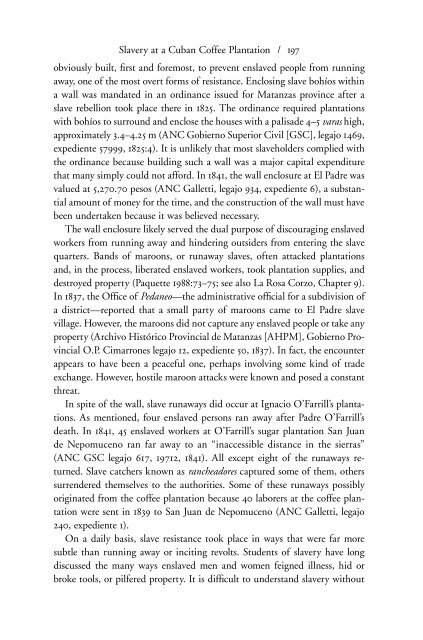Dialogues in Cuban Archaeology
by L. Antonio Curet, Shannon Lee Dawdy, and Gabino La Rosa Corzo
by L. Antonio Curet, Shannon Lee Dawdy, and Gabino La Rosa Corzo
You also want an ePaper? Increase the reach of your titles
YUMPU automatically turns print PDFs into web optimized ePapers that Google loves.
Slavery at a <strong>Cuban</strong> Coffee Plantation / 197<br />
obviously built, ¤rst and foremost, to prevent enslaved people from runn<strong>in</strong>g<br />
away, one of the most overt forms of resistance. Enclos<strong>in</strong>g slave bohíos with<strong>in</strong><br />
a wall was mandated <strong>in</strong> an ord<strong>in</strong>ance issued for Matanzas prov<strong>in</strong>ce after a<br />
slave rebellion took place there <strong>in</strong> 1825. The ord<strong>in</strong>ance required plantations<br />
with bohíos to surround and enclose the houses with a palisade 4–5 varas high,<br />
approximately 3.4–4.25 m (ANC Gobierno Superior Civil [GSC], legajo 1469,<br />
expediente 57999, 1825:4). It is unlikely that most slaveholders complied with<br />
the ord<strong>in</strong>ance because build<strong>in</strong>g such a wall was a major capital expenditure<br />
that many simply could not afford. In 1841, the wall enclosure at El Padre was<br />
valued at 5,270.70 pesos (ANC Galletti, legajo 934, expediente 6), a substantial<br />
amount of money for the time, and the construction of the wall must have<br />
been undertaken because it was believed necessary.<br />
The wall enclosure likely served the dual purpose of discourag<strong>in</strong>g enslaved<br />
workers from runn<strong>in</strong>g away and h<strong>in</strong>der<strong>in</strong>g outsiders from enter<strong>in</strong>g the slave<br />
quarters. Bands of maroons, or runaway slaves, often attacked plantations<br />
and, <strong>in</strong> the process, liberated enslaved workers, took plantation supplies, and<br />
destroyed property (Paquette 1988:73–75; see also La Rosa Corzo, Chapter 9).<br />
In 1837, the Of¤ce of Pedaneo—the adm<strong>in</strong>istrative of¤cial for a subdivision of<br />
a district—reported that a small party of maroons came to El Padre slave<br />
village. However, the maroons did not capture any enslaved people or take any<br />
property (Archivo Histórico Prov<strong>in</strong>cial de Matanzas [AHPM], Gobierno Prov<strong>in</strong>cial<br />
O.P. Cimarrones legajo 12, expediente 50, 1837). In fact, the encounter<br />
appears to have been a peaceful one, perhaps <strong>in</strong>volv<strong>in</strong>g some k<strong>in</strong>d of trade<br />
exchange. However, hostile maroon attacks were known and posed a constant<br />
threat.<br />
In spite of the wall, slave runaways did occur at Ignacio O’Farrill’s plantations.<br />
As mentioned, four enslaved persons ran away after Padre O’Farrill’s<br />
death. In 1841, 45 enslaved workers at O’Farrill’s sugar plantation San Juan<br />
de Nepomuceno ran far away to an “<strong>in</strong>accessible distance <strong>in</strong> the sierras”<br />
(ANC GSC legajo 617, 19712, 1841). All except eight of the runaways returned.<br />
Slave catchers known as rancheadores captured some of them, others<br />
surrendered themselves to the authorities. Some of these runaways possibly<br />
orig<strong>in</strong>ated from the coffee plantation because 40 laborers at the coffee plantation<br />
were sent <strong>in</strong> 1839 to San Juan de Nepomuceno (ANC Galletti, legajo<br />
240, expediente 1).<br />
On a daily basis, slave resistance took place <strong>in</strong> ways that were far more<br />
subtle than runn<strong>in</strong>g away or <strong>in</strong>cit<strong>in</strong>g revolts. Students of slavery have long<br />
discussed the many ways enslaved men and women feigned illness, hid or<br />
broke tools, or pilfered property. It is dif¤cult to understand slavery without


















